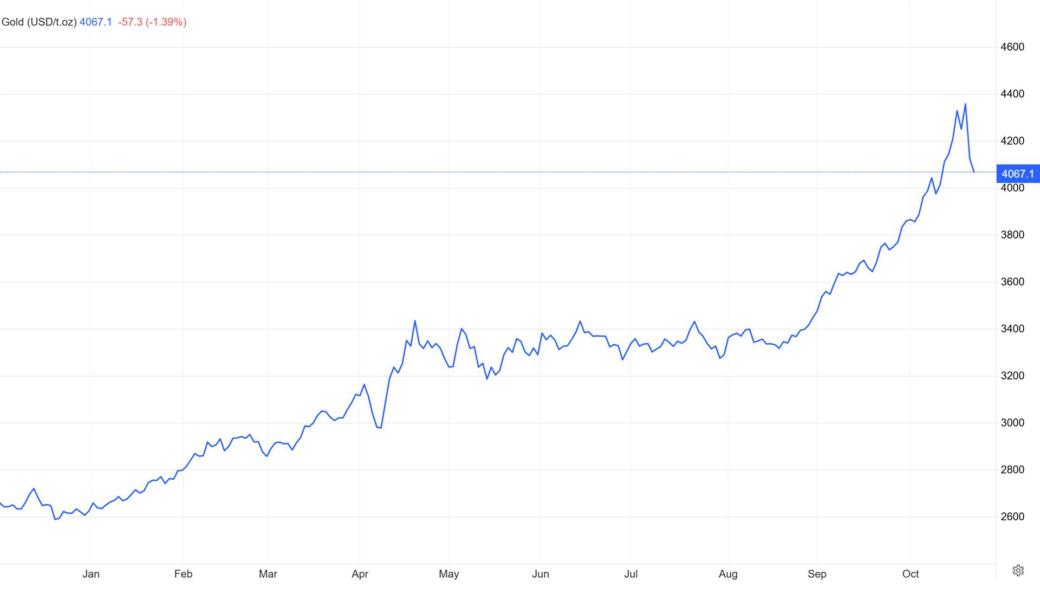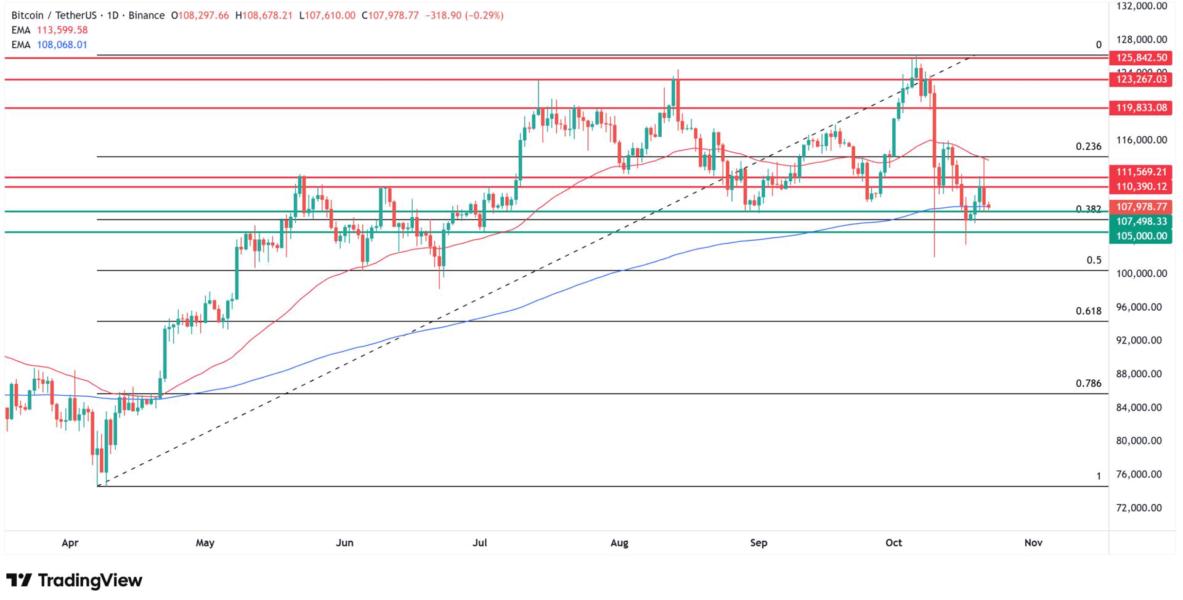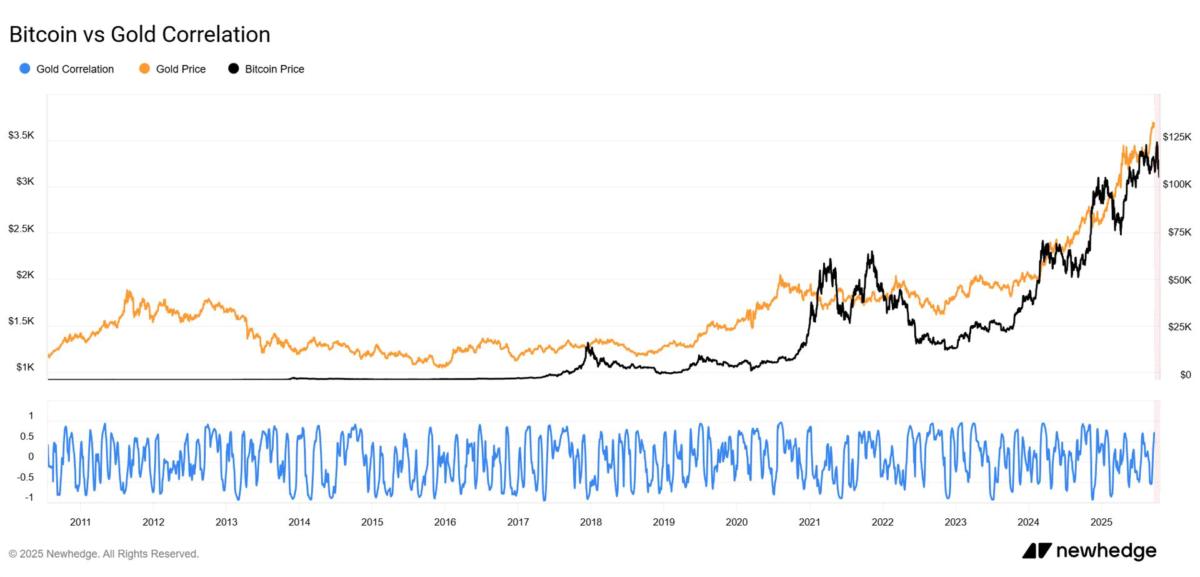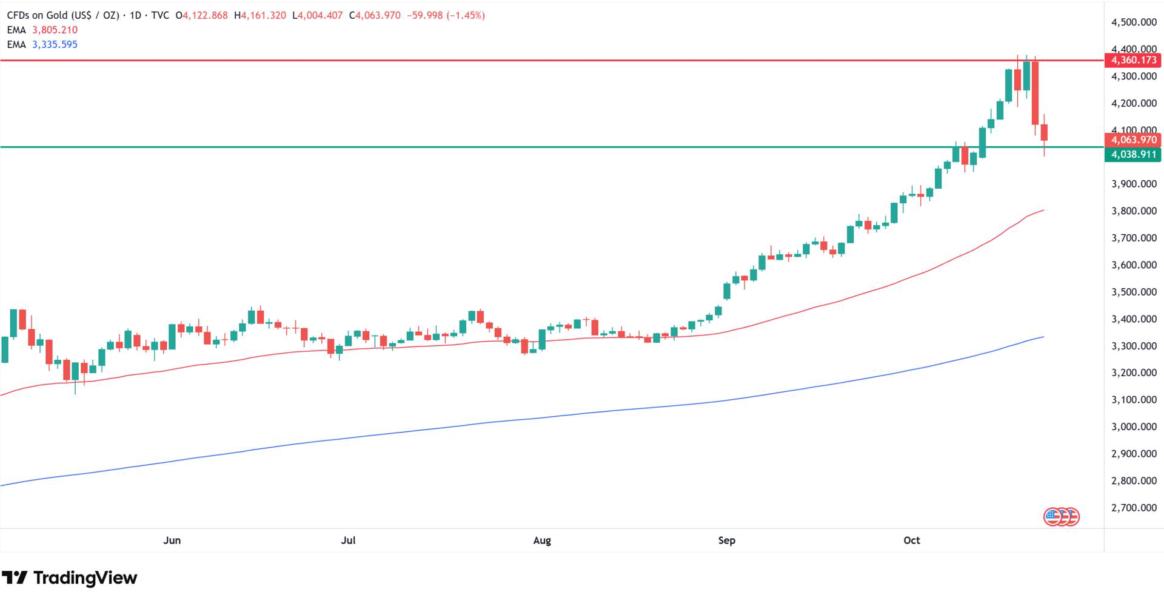Why Gold Price Is Falling the Most Since 2020? The Crash Is Dragging Bitcoin Down Too
Gold price experienced its most severe single-day collapse in over five years this week, plunging more than 5% from record highs and dragging Bitcoin (BTC) lower in a synchronized selloff that erased billions in market capitalization.
The precious metal fell from Monday's all-time peak of $4,381 per ounce to an intraday low of $4,082, marking the steepest decline since August 2020’s 5.7% crash. Bitcoin simultaneously dropped over 2%, falling from $110,000 levels to test critical support at $108,000 as the correlation between digital and physical safe-haven assets reached 0.85.
Why Gold Price Is Crashing?
The gold crash followed an unsustainable rally that saw prices surge 60% throughout 2025 and 25% in just the previous two months, creating what analysts described as "stratosphere" conditions ripe for correction.
Standard Chartered analyst Suki Cooper characterized the movement as a "technical correction" after record-breaking precious metals inflows totaling $34.2 billion over ten weeks pushed the market into severely overbought territory. Bart Melek, global head of commodity strategy at TD Securities, confirmed dealers were "realizing gains after a strong rally" that proved unsustainable long-term.

Gold price chart today. Source: TradingEconomics.com
Profit-taking accelerated as the US dollar index strengthened 0.4%, making gold more expensive for international buyers and reducing its appeal against competing assets. The timing coincided with renewed optimism over US-China trade negotiations, with President Trump expressing confidence about reaching a deal with Chinese President Xi Jinping at their scheduled meeting. This easing of geopolitical tensions diminished safe-haven demand that had propelled gold to consecutive record highs.
Physical demand also weakened following the conclusion of the Diwali festival in India, the world's second-largest gold consumer, removing a significant source of buying pressure. Silver crashed even harder at 8.7% in its worst single-day drop since February 2021, while platinum fell 5-7%, confirming the broad-based precious metals correction.
Why Bitcoin Price Is Going Down Today?
Bitcoin's decline mirrored gold's weakness as the strengthening correlation between the two assets, currently at 0.85, near the all-time high of 0.9 reached in April 2024, caused synchronized selling pressure. The cryptocurrency ended Tuesday's session at $108,342, dropping over 2% and retesting local support around the $108,000 level that coincides with late August lows and marks the lower boundary of the months-long consolidation range.
From my technical analysis of Bitcoin's chart, the price attempted to strengthen on Monday before ultimately pulling back sharply in direct reaction to gold's crash. Bitcoin tested the critical support zone around $108,000, which aligns with late August lows and represents the lower boundary of the consolidation drawn since mid-October.
Importantly, the 200-day exponential moving average continues to provide support, meaning we remain technically in a bull trend. However, a breakdown below this range would open the door to further declines and a test of the $100,000 level, a major psychological support zone.

Why Bitcoin price is going down today? Source: Tradingview.com
Paul Howard from Wincent noted that "many analysts follow technical trends including M2 money supply, gold, stock2flow models plus other metrics as ways to predict Bitcoin's next move. Arguably many now indicate a big upswing and with so many leveraged longs and shorts liquidated, and a positive global macro environment may see Bitcoin as a gold laggard". The comment highlights how Bitcoin's underperformance relative to gold's earlier rally may reverse following the liquidation cleanup.
Please also check my previous articles including Bitcoin and gold price predictions:
Key Market Indicators for Gold and Bitcoin
Metric | Value | Change | Significance |
Gold Price (Oct 22) | $4,082 | -5.6% | Worst drop since August 2020 |
Bitcoin Price (Oct 22) | $108,342 | -2.1% | Testing August support levels |
Silver Price | $51.89 | -8.7% | Worst drop since February 2021 |
Gold-Bitcoin Correlation | 0.85 | Near ATH | Explaining synchronized selloff |
US Bitcoin ETF Flows | -$40.47M | Outflows | Institutional caution |
Crypto Market Cap | $3.76T | -2.3% | Broad-based decline |
Gold-Bitcoin Correlation Drives Synchronized Selloff
The increasingly tight correlation between gold and Bitcoin, rising from negative 0.8 in October 2021 to current levels of 0.85, explains why both assets experienced simultaneous pressure.
Mostafa Al-Mashita, Co-founder & Director of Sales and Trading at Secure Digital Markets, provided exclusive analysis: "Gold's loss of neutrality and Bitcoin's rise as a borderless asset mark a fundamental shift in global value dynamics. The recent gold sell-off, though expected after an extended rally, underscores how traditional havens are becoming tools of policy rather than stores of neutrality".

Source: Newhedge.io
He continued: "Nations like China, India, and Turkey are stockpiling gold to reduce reliance on the US dollar, turning it into a geopolitical instrument tied to state agendas. Bitcoin, though increasingly adopted by institutions and states, remains structurally decentralized and resistant to control. It signals economic independence while functioning as both a volatile trading vehicle and a modern store of value. This isn't simply gold versus Bitcoin; it's a broader reallocation of trust, with governments asserting sovereignty through gold and individuals and institutions seeking autonomy through Bitcoin".
Initially on Tuesday, Bitcoin actually surged as gold crashed, briefly jumping above $113,000 as traders rotated capital from precious metals into crypto. Analyst Ash Crypto declared "the rotation from gold to Bitcoin has begun," while Swissblock research pointed to similar patterns in April when gold fell 5% over three days before Bitcoin rallied from its macro bottom. However, this rotation proved short-lived as broader risk-off sentiment eventually pulled Bitcoin lower.
Gold Technical Analysis and Price Outlook
After reaching new all-time highs in the daily chart, gold stalled at resistance around $4,350 per ounce, which after several sessions of accumulation triggered dynamic depreciation on Monday with a drop exceeding 5% to $4,124 per ounce. According to my technical analysis, tuesday brought continued declines of 1.5% and a test of the psychological $4,000 level. At the time of writing, the metal was changing hands at $4,062, bouncing slightly from local support defined by the all-time highs from October 8-9.

Technical analysis of the gold chart. Source: Tradingview.com
Gold has significantly more room for correction, and I would not rule out a descent toward $3,400, the 200-day exponential moving average, before a stronger rebound materializes. The $2.1 trillion in market capitalization erased on Tuesday alone, equivalent to 55% of the entire cryptocurrency market's value according to trader Peter Brandt, demonstrates the magnitude of this correction.
Critical Support and Resistance Levels
Gold Technical Levels:
- Immediate resistance: $4,200-$4,235 markingprevious consolidation highs
- Current price: $4,062 with slight bouncefrom October 8-9 ATH support
- Psychological support: $4,000 round numbertesting investor confidence
- Key support zone: $4,035 representing near-termfloor
- Bearish invalidation: $3,965 breakdown wouldconfirm deeper correction
- Major correction target: $3,400 aligning with 200-dayEMA
Bitcoin Technical Levels:
- Consolidation resistance: $110,000-$113,000 upperboundary tested Monday
- Current price: $108,342 retesting criticalsupport zone
- Key support: $108,000 coinciding with lateAugust lows and consolidation floor
- Bull trend support: 200-day EMA maintainingbullish structure
- Psychological level: $100,000 majorsupport if current range breaks
Historical Crash Comparison: Bitcoin, Gold and Silver
Event | Date | Decline | Recovery Time | Cause |
Gold Crash | August 2020 | -6.3% | 3 months | Cypruscrisis, Fed taper talk |
Gold Crash | Oct 21, 2025 | -5.6% | TBD | Profit-taking, dollar strength |
Silver Crash | Feb 2021 | -8.7% | 6 weeks | Reddit squeeze unwind |
Bitcoin Crash | Oct 10, 2025 | -14% | 2 weeks | Leverage liquidation |
Gold Correction | Aug 2020 | -5.0% | 4 months | Post-COVID rally exhaustion |
Bitcoin and Gold Price Analysis, Frequently Asked Questions
Why did gold crash 5% on October 21, 2025?
Gold crashed 5-6% due to profit-taking after a 60% rally in 2025, combined with a stronger US dollar, easing US-China trade tensions, and technical correction from overbought conditions following $34.2 billion in precious metals inflows over ten weeks.
When was the last time gold fell this much in one day?
The last time gold experienced a comparable or larger single-day decline was August 2020, when it dropped 5.7% during the Cyprus banking crisis and Federal Reserve tapering concerns.
Why is Bitcoin falling with gold?
Bitcoin fell alongside gold because the correlation between the two assets reached 0.85, near the all-time high of 0.9, causing synchronized selling pressure as investors treated both as linked safe-haven assets.
Is the gold rally over?
Analysts view this as a technical correction rather than the end of the bull market, with gold potentially correcting toward $3,400 (the 200-day EMA) before resuming its uptrend, though the rally's pace needed to slow from unsustainable levels.
Why Bitcoin is crashing?
Bitcoin remains in a technical bull trend as long as the 200-day EMA holds as support around $108,000, though a breakdown below this level would open the path to testing $100,000 psychological support before a potential recovery.
What caused silver to drop 8.7%?
Silver crashed 8.7% in its worst day since February 2021 due to the same factors affecting gold—profit-taking, dollar strength, and easing geopolitical tensions—amplified by silver's higher volatility and smaller market size.